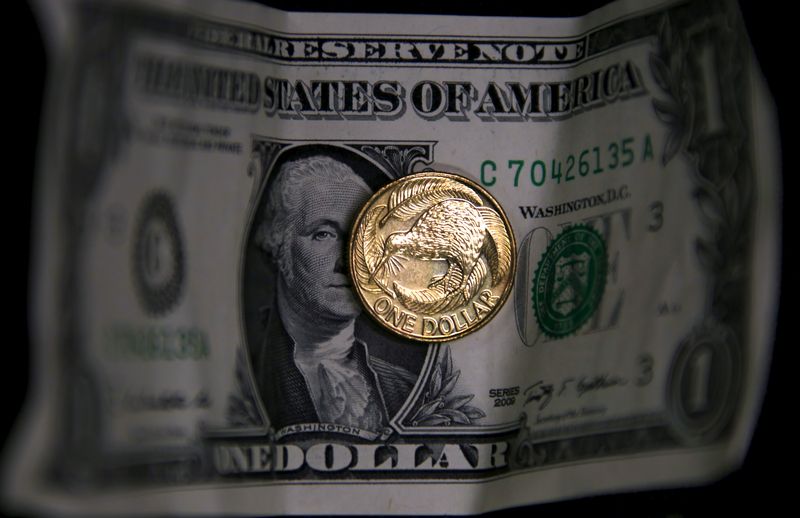Forex
Euro zone inflation dents euro, dollar rises from three-month low


© Reuters. FILE PHOTO: A New Zealand dollar coin sits atop a United States one dollar bill in this photo illustration taken on March 11, 2016. REUTERS/David Gray/Illustration/File Photo
By Samuel Indyk
LONDON (Reuters) -The euro fell on Thursday after euro zone inflation eased by more than forecast this month, fuelling bets of early European Central Bank rate cuts, while the dollar rose from a three-month low but was still set for its biggest monthly drop in a year.
Consumer price growth in the 20 nations that share the euro currency dropped to 2.4% in November from 2.9% in October, well below expectations for a fall to 2.7%.
“The message from today’s European CPI data is clear,” said Matthew Landon, global market strategist at J.P. Morgan Private Bank. “Disinflation is continuing at a rapid pace in Europe – and, importantly, more swiftly than the market or even the ECB’s expectations.”
“Falling inflation and a stagnant economy could justify ECB cuts as soon as the first quarter of next year in our view,” Landon said.
The euro dropped as much as 0.5% against the dollar to $1.0910 and last stood at $1.0930. On Wednesday it hit its highest level since August at $1.1017.
Markets are now fully pricing in a rate cut from the ECB by April, while around 115 basis points of easing is priced by the end of next year.
ECB policymaker Fabio Panetta said on Thursday the central bank may be able to ease monetary conditions if persistently weak output accelerates the decline in inflation.
Meanwhile, the , which measures the U.S. currency against six others including the euro, rose 0.4% to 103.25, picking up after touching 102.46 on Wednesday, its lowest level since Aug. 11.
The index is still down around 3.3% in November, its biggest monthly fall since last November, on growing expectations the Fed will also cut interest rates in the first half of 2024.
“The key drivers in November for the dollar weakness have been the benign inflation data and the loosening signs of the labour market,” said Mohamad Al-Saraf, associate, FX and rates strategy at Danske Bank.
“The notion of a soft landing has increased and usually that’s a bad environment for the dollar.”
Investors will be all ears on Friday when Fed Chair Jerome Powell takes centre stage in the wake of Fed Governor Christopher Waller on Tuesday flagging a possible rate cut in the months ahead. It will also be the last time Fed policymakers will be able to share their views before they enter the quiet period before the December policy meeting.
Before that, the spotlight will firmly be on Thursday’s crucial personal consumption expenditure (PCE) price index – the Fed’s targeted measure of inflation.
Christopher Wong, currency strategist at OCBC, said the data will offer a glimpse into whether the disinflation trend seen so far remains intact.
“If core PCE undershoots expectations to the downside, then USD may extend the move lower again,” he said.
U.S. rates futures markets are now pricing in more than 100 bps of rate cuts next year starting in May, and the two-year Treasury yield is close to its lowest since July – it has slumped about 40 bps this week alone.
Meanwhile, expectations that the Bank of Japan will soon end its negative rate policy have pulled the yen up from the depths, and in the process, eased pressure on the central bank to support the currency via direct FX market intervention.
On Thursday, the yen weakened 0.2% to 147.575 per dollar, but remains close to the two-and-a-half-month high of 146.675 per dollar it touched on Wednesday. The Japanese currency has firmed almost 3% against the dollar in November and is on course for its strongest month this year.
Bank of Japan board member Toyoaki Nakamura said on Thursday the central bank will likely need some more time before phasing out its massive stimulus.
Sterling was last at $1.2655, down 0.3% on the day, while the Australian dollar fell 0.2% to $0.6605. It’s still up 4.2% in November – its steepest one-month gain in a year.

 Forex3 years ago
Forex3 years agoForex Today: the dollar is gaining strength amid gloomy sentiment at the start of the Fed’s week

 Forex3 years ago
Forex3 years agoUnbiased review of Pocket Option broker

 Forex3 years ago
Forex3 years agoDollar to pound sterling exchange rate today: Pound plummeted to its lowest since 1985

 Forex3 years ago
Forex3 years agoHow is the Australian dollar doing today?

 Cryptocurrency3 years ago
Cryptocurrency3 years agoWhat happened in the crypto market – current events today

 World3 years ago
World3 years agoWhy are modern video games an art form?

 Commodities3 years ago
Commodities3 years agoCopper continues to fall in price on expectations of lower demand in China

 Economy3 years ago
Economy3 years agoCrude oil tankers double in price due to EU anti-Russian sanctions





















